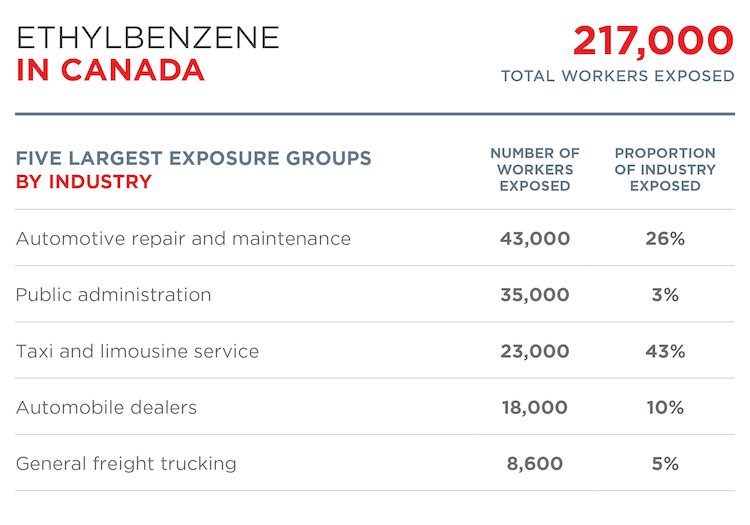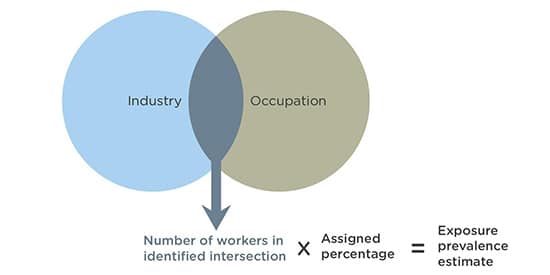Ethylbenzene Occupational Exposures
Ethylbenzene Occupational Exposures
Overview
Inhalation is the most important route of occupational exposure.[1] CAREX Canada estimates that approximately 217,000 Canadians are exposed to ethylbenzene in their workplaces. Industrial groups that typically operate in or around areas where combustion products accumulate tend to be at higher risk for ethylbenzene exposure.
READ MORE...
The largest exposed industrial groups are automotive repair and maintenance, public administration (firefighters), taxi and limousine services, and automotive dealers. The largest exposed occupational groups are automotive service technicians, truck and bus mechanics; firefighters; and professional drivers (e.g. taxi, limousine, or truck drivers, chauffeurs).
Occupational exposure to ethylbenzene can also occur during production and handling of ethylbenzene or while using mixed xylenes, which are used as solvents for paints, inks, lacquers, and in rubber and plastic production.[2] Exposure can also occur in coal and petroleum refining and in production and handling of gasoline and bitumens.[1]
Although ethylbenzene is used in styrene production, exposure is expected to be low since the process is typically enclosed.[3] Low levels of ethylbenzene were reported in the 1990s as a by-product of styrene production.[1]
Prevalence Estimate
Results show that approximately 217,000 Canadians are exposed to ethylbenzene in their workplaces; 94% of these workers are male. The largest exposed industry group is automotive repair and maintenance, public administration (where firefighters are captured), taxi and limousine service, and automobile dealers.
When exposure is examined by occupation, the largest exposed groups are automotive service technicians, truck and bus mechanics (75,000 workers exposed), firefighters (30,000 workers exposed), taxi and limousine drivers and chauffeurs (29,000 workers exposed), and transport truck drivers (16,000 workers exposed).
The number of workers exposed to ethylbenzene increased by approximately 8,200 workers from 2006 to 2016 (a 4% increase). This was primarily driven by an increase in the total number of truck and bus mechanics, taxi drivers, and truck drivers.
Workers exposed to ethylbenzene by industry in 2016

Workers exposed to ethylbenzene by region in 2016
Click the second tab to view total number of workers exposed.
* = < 50 workers
Methods and Data
Our Occupational Approach page outlines the general approach used to calculate prevalence and exposure level estimates for workplace exposures.
Data Sources
Data used in developing the occupational estimates for ethylbenzene were collected from several sources:
- The Canadian Workplace Exposure Database (CWED) contains over 1,500 measurements for ethylbenzene exposure. These measurements were collected during the years 1981 to 2004 in Ontario and British Columbia workplaces.
- Canadian and US scientific peer reviewed publications that addressed ethylbenzene exposure in Canada and the United States.
- Grey literature including technical reports from governments and international bodies.
Prevalence Estimate Method
CAREX defines exposure to ethylbenzene as inhalation exposure at work to levels significantly exceeding background environmental levels.
To determine the number of workers potentially exposed to ethylbenzene at work, CAREX occupational exposure experts used methods previously established in other peer-reviewed CAREX projects in Europe. A series of steps were taken to assign exposure proportions to occupations and industries at risk of exposure to ethylbenzene.

- Occupations and industries at risk of possible exposure to ethylbenzene were identified using any combination of data sources described above.
- The total number of workers in each identified occupation and industry intersection was obtained from Statistics Canada 2016 census data.
- A percentage of workers exposed was assigned to that occupation and industry intersection. Percentages were determined by consultation with existing evidence in the data sources, previously established methods from the Europe CAREX estimates and the expert judgement of CAREX occupational hygienists.
- The number of workers in the identified group is multiplied by the assigned percentage to calculate the prevalence estimate of workers exposed to ethylbenzene.
Sources
Subscribe to our newsletters
The CAREX Canada team offers two regular newsletters: the biannual e-Bulletin summarizing information on upcoming webinars, new publications, and updates to estimates and tools; and the monthly Carcinogens in the News, a digest of media articles, government reports, and academic literature related to the carcinogens we’ve classified as important for surveillance in Canada. Sign up for one or both of these newsletters below.
CAREX Canada
School of Population and Public Health
University of British Columbia
Vancouver Campus
370A - 2206 East Mall
Vancouver, BC V6T 1Z3
CANADA
As a national organization, our work extends across borders into many Indigenous lands throughout Canada. We gratefully acknowledge that our host institution, the University of British Columbia Point Grey campus, is located on the traditional, ancestral, and unceded territories of the xʷməθkʷəy̓əm (Musqueam) people.



